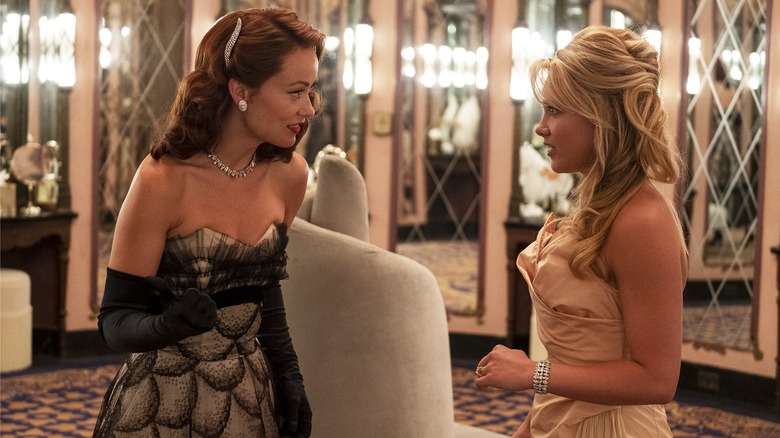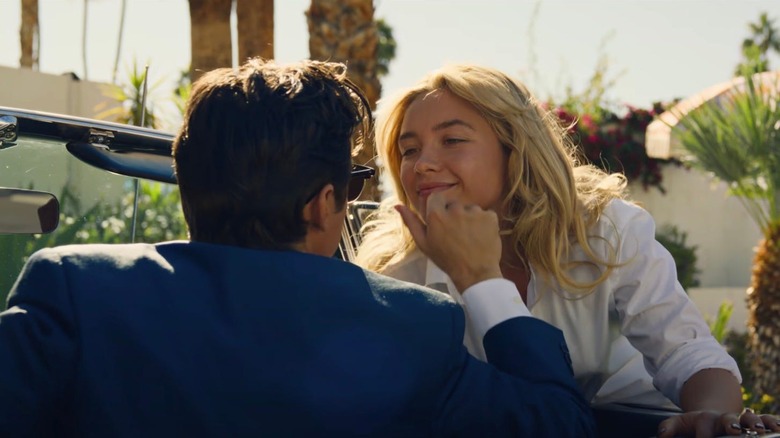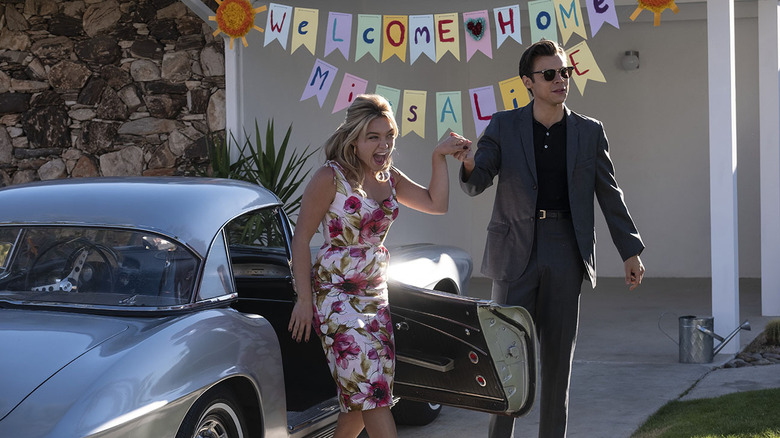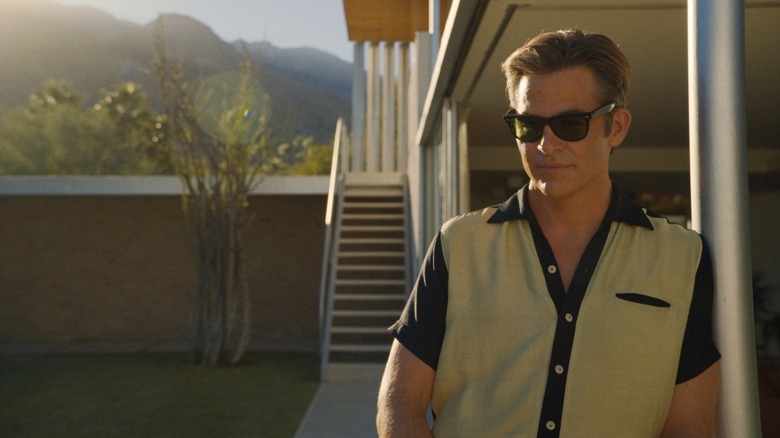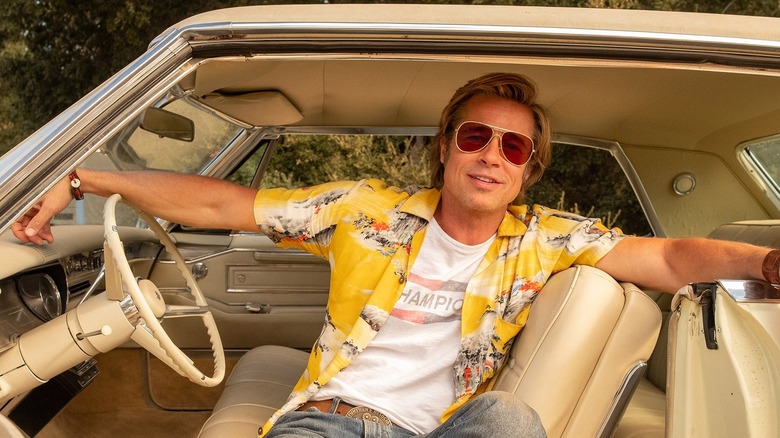Don't Worry Darling Costume Designer Arianne Phillips Is A People Detective [Interview]
Arianne Phillips describes herself as a people detective. It's an especially cool alternate title for a costume designer. She wants to understand the soul of the story, the characters, and the actors, and how to help best present all three for a filmmaker. For director Olivia Wilde's "Don't Worry Darling," she had quite a visual feast to cook up in this '50s world where everything isn't what it seems.
Phillips is the name behind several iconic costumes in film. She worked on "The Crow," "Hedwig and the Angry Inch," and scored one of her three Academy Award nominations for her work in "Once Upon a Time in... Hollywood." The artist's inspiring work goes beyond the world of film, as well. For years, she's worked in theater, collaborated with the likes of Madonna and Tom Ford, and contributed to opera and striking photo shoots. Recently, Phillips talked to us about "Don't Worry Darling," her vision as a costume designer, and experience with Quentin Tarantino.
'Culturally, I think this really, hopefully, provokes conversation around'
Whenever you start a project, you ask yourself, "What can I add to this story?" So what did you want to add to "Don't Worry Darling?"
Okay. Are you quoting me? Are you quoting just in general?
I'm quoting you.
Oh good, because I was like, "Oh, does everyone say that?" No, absolutely. That's kind of the thought process I put myself through whenever I get a script, and it's like, "Can I add something to this?" Also, can I learn something? Because I'm not really interested in repeating myself and I actually have worked on quite a few films in this time period. Quite a few. I can say, let's see. "Girl, Interrupted."
"Walk the Line."
"Walk the Line" and "A Single Man." "Once Upon a Time in... Hollywood" was late '60s, but also a changing time because our movie's late '50, early '60s, which is also something I really love. I'm working on a film right now, that's working on a changing time too. I like the turn of decades, because it gives you an opportunity to have a little bit of, like in our film, a little '50s and a little '60s. So I look for that, but yes, it's true.
Weirdly, of all your past work, "Identity" came to mind for this, focuses on just the idea of people playing roles.
For sure. I always think about archetypes when I'm reading a script. Oftentimes, when you're telling a story, I have to be able to have the ability to reduce it down. I'm always looking for a character arc in costumes, I'm always looking for films that have some sort of transformative aspect to it, whether it's literally the characters or the story. This had that in spades, just in terms of the larger conversation about the male gaze, and this is kind of a time like 2017. But 2018 was this third wave of feminism, and generationally, having the conversations again about patriarchy and about control and women's voices.
I felt that it was super relevant that we would have a film that would look back at these super binary gender roles of the '50s and '60s, and we're at a place in time now where we are much more open to being, to non-binary, to different gender conversations. Also, at the same time, as a country becomes more conservative and reactionary, kind of post-Trump. We made this during Trump. I never ever thought here we'd be at 2022 with Roe v. Wade being overturned. And that in my lifetime, women's healthcare would be so at stake. So it has had resonance when we made it two years ago and even more so now as almost a cautionary tale. I think I just went on a tangent, did I even answer your question?
[Laughs] You did, and answered a few other questions I had. Sadly, we still see that conservative response to fashion. Obviously, going back, there was glamrock and what David Bowie and Mick Jagger did, but even in the '90s, you and Lenny Kravitz followed in those footsteps. All these years later, there are still those intense reactions to people dressing how they want.
Yeah, I kind of came up in that world. The thing about Lenny is that we started together. We were friends before his first record, and he and I were both starting out on our careers in New York at the same time. The silhouette that I wanted for Lenny, it didn't exist in the store, so I literally put women's clothes on him. I think I went to the Baby Gap and bought little turtlenecks for him that were shrunken. I put all kinds of women's clothes on him, and I got s**t for it, too, from his record company and stuff. It was because we were really informed by not only David Bowie, but Robert Plant used to do that. And even Jimi Hendrix would wear these kinds of feminized velvet tops and different proportions and stuff.
Then I ended up working with Madonna for 20 years. She's known for pushing those boundaries of gender and presentation. So it's kind of in me. "Don't Worry Darling," it's really only a generation or two generations ago that women were expected to live under these societal norms, and men for that matter as well. And this is to say that this still exists in certain cultures in our own country, certain religious communities, and also in other cultures in the world.
Even though it seems like ancient history, maybe to someone in their twenties, this is still relevant today. Also, just these conversations around control, not just women, but LGBTIQ, I mean there's a lot there. Culturally, I think this really, hopefully, provokes conversation around.
'Who knew we would be making this movie in the middle of a pandemic?'
How'd you want to help create Alice's identity with clothing?
Well, I was very aware that the audience is experiencing Victory in real time with Alice. We're trying to figure out what Victory's about as well, the audience members. I really wanted to design a film that was beautiful and seductive and really lean into the mid-century design, so that the audience would also be seduced by Victory and it would be beautiful.
I always start with silhouettes in color. I was really informed by a lot of art of the time. I took a lot of cinematic license using color, and I looked at a lot of prints that maybe had the energy of Jasper Johns or Jackson Pollock, or the beautiful colors of Mark Rothko that were really heightened. This informed the costumes a lot for me. I wanted them to feel almost hyper real, knowing these early conversations with Olivia and Matty [Libatique], the cinematographer, and Katie Byron, the production designer, are so crucial for the world that we chose to create with Olivia.
It all really started with Olivia's mood boards. She created these beautiful mood boards that really were quite sophisticated in terms of her reference. One of the super exciting things about wanting to work on this project is getting to know Olivia, and she's really, she's a unicorn. She's so smart, and I only knew her as an actor. And of course, I was a fan of "Booksmart."
When I read the script, I was super surprised that this was her sophomore effort, because I don't know what I was expecting, but it kind of resonated, because one of the things I like about Olivia, but that when I didn't know her, is that she's an activist. She's outspoken. I follow her on social media, I have a friend that knows her, and I know that she's really involved in women's issues and stuff. So it made sense to me when I read the script, I was like, "Oh yeah." And it's a similar sensibility for me. It felt super timely. Who knew we would be making this movie in the middle of a pandemic? When we first met, it was before COVID.
What were the conversations you had with Matty and Katie about? How'd you all land on the same page?
Well, we shared a lot of visual references. For us visual people, it's better to show visual reference. It's hard to articulate, but we also did camera tests and that sun was omnipresent in the camera tests. I knew that I could, in the same way, have an intensity in the color palette for the costumes, knowing how it was going to be lit. We did have a lot of interiors, and a lot of our film was shot on a stage that was built by the brilliant Katie Byron. So yeah, it was fun. That's the juicy stuff. For me, it's all in the preparation, and then you prepare the world, and then for me, you hand it over to the actors, and then it takes on its own life.
That prep time and collaborating with Olivia was great. Some directors have you siloed where they don't have a lot of crosstalk with the other departments, and they kind of micromanage it. Everyone's different, but Olivia was very inclusive. We had a lot of these group discussions, the four of us with Katie and Matty and Olivia, and that, for me, is what makes my work better, being able to be inspired by what the context of the set will be, the work of the cinematographer. Then, of course, what's happening between Olivia and the actors, and these conversations and the discoveries they're having in rehearsals, all that really helps me along the way while we're prepping.
'Costumes can really be also about nuance and tone and mood'
Like you said, there are a lot of interior scenes, and usually with only a few characters, but where do you start when you start working on a scene with as many extras as the ceremony/party?
I will say that, when I first read it, I was like, "There's a lot of description of this sexual tension in the room." And I was like, "Wow, Dita Von Teese should be in this, she would be perfect for this." She happens to be a friend and a neighbor. So I just casually mentioned Olivia, we were having a meeting. I'm like, "You should have Dita." And she's like, "Oh gosh, that would be incredible. I don't even know how that could happen." I'm like, "Well, let me just send her a text." I sent her a text, and at the time, because we were shooting just after lockdown, she had to cancel her tour, and she's like, "Yeah, I'm home bored, I would love it." So it worked out, and that was really fun to have her there, because I think that really added to that sexual tension that was on page and the debauchery and the decadence of that scene.
For me, I think that was really fun and I love doing those costumes and, I asked Bulgari, who's a really famous jewelry brand, if we could use some of their high archival jewelry, so that was really fun. But actually the part of that shooting that I enjoyed the most was the scene between Bunny [Wilde] and Alice [Florence Pugh] in the powder room. The way Matty shot that room, it's a total mirrored room with that beautiful kind of round settee ottoman thing that Katie had in the middle of the room. I love that scene. I thought it was particularly beautiful the way it was shot and designed.
It's funny you mention the sexual energy, because Chris Pine looks like he either wants to kiss or kill someone in this movie. How'd you want to help establish him as this powerful cult figure?
Oh, it's all Chris Pine. I love his work in this movie. Chris personally likes to be barefoot a lot. The scene when everyone's at his house, and they're talking about him and Shelley's house, then changing the world, and it's the exterior scene by the pool, Chris wanted to do the scene barefoot. I'm like, "100%." Frank has this cocky cult leader confidence, and he's gorgeous. He looks like the perfect man and figurehead, the kind of man that I think men and women want to be and are in love with. He has that in spades. So costumes really didn't do much. I just had to underscore what he was doing already.
It was a really crazy time to make a movie. We were one of the first adapters to come out of the gate post-lockdown to make a film. I think most films had been started up during COVID and went back up. But I believe we're the first film that kind of started from zero post-COVID. For me, it was nerve-wracking, because trust is such an important part of my job. I'm the only department that meets an actor, and then they have to get naked and trust me, right? That is always reading people's facial expressions and body language. I didn't know how that was going to work with masks ,and we didn't even just have masks, we had visors as well. So one of the things that I asked for was to have Zoom meetings with the actors first so that I could meet them without a mask, like we're talking now. And it was so great.
So I first met Chris on Zoom. It was great because he was at home and he was relaxed. Chris is also such a thoughtful actor and spent a lot of time thinking about Frank and doing research and who he would be. So we had an hour-long session on Zoom, which really, really helped me. By the time I met Chris in-person, there was a beginning of a relationship and an understanding, and it made a difference for me. I don't know if it made a difference for him, but it made a difference for me, because my goal is always so it's just like my relationship with the director. I want to get in their head and I want to understand their process and what will help them, and at the same time bring something to it.
It's ephemeral. Costumes can really be also about nuance and tone and mood, so that's a part of my job I love. I always say costume designers are people detectives, because it's a psychological assessment of not only the character, but the actor, the director, and how I'm going to help them get there. Because for some actors, costumes are a huge part of their process, and other actors, it's not at all. So you never know what you're getting. Some actors really want that tactile experience of being in a costume to transport them to a time and a place, and with other actors, it couldn't be less important to them.
Which actors have you collaborated with that, like you said, costumes are a huge part of their process?
Well, I wouldn't say I know, but it's just because I haven't asked them if they're important, but just their level of commitment. So Florence, just in speaking about this movie, Florence and Chris were both incredibly engaged with the conversations around the costumes. They had a lot of costume changes, but I think Harry was more curious about the process being new to acting. He's a brilliant performer. I think the thing about Harry Styles that's so genius is that he does play with clothing in a way that is super bold and playful and at times non-binary, there's a curiosity there. It was almost odd to put Harry in these '50s clothes, because he has an incredible personal style. To see him in such a character, really embracing that rat pack bro culture that I don't think of him as. To his credit, he looked so good in the clothes. I think they really helped us. I think celebrity can be tricky when watching films. I hope that people believe. I hope that costumes and the hair and the makeup help the audience, especially the young people that are going to come see it because he's in it. I hope it helps suspend belief so they can engage with the work that Harry does. I think Harry does a really stellar job in this movie.
'How can I follow that up?'
I just want to say, you made one of my favorite costume designs of the last few years in "Once Upon a Time in... Hollywood." Towards the end of that movie, you see Rick Dalton dressed, in his own way, a little more hip. He's slowly accepting the moment of time he's in, not just the past. It really shows growth, just that costume.
Oh, thank you so much. That film was so juicy in terms of costumes for me and storytelling and Quentin [Tarantino]. It was my first time working with him, and he has a reputation for being very exacting. One thing I learned about working with Quentin is that he expects his fellow filmmakers and collaborators to be as versed in that case, in the lore and the history of the time, referencing television and films from the time and the world that Rick Dalton would've lived in.
I think we shot over six months, and we shot pretty much in continuity. So by the time we got to the end of the film, I think Quentin and I knew each other a lot better. He was really open because you see Rick's sideburns, and you see hat change when he comes back from Italy. It's a little cheesy, he's not a hippie. It's definitely more in the Wayne Newton world, kind of.
Leo also was so brilliant, and sometimes actors just really surprise me about how they are brilliant actors. They lean into hair and makeup and costume to help them. That really was a big story arc, so that was a lot of fun. I remember, I had to fit those costumes on set because I couldn't fit the whole movie before we started shooting. So we had to do it on set, so that we could also show Quentin at the same time. Not the same day, but in advance of shooting. I remember when they put the sideburns on and the wig and everything, oh my God. I had a lot of fun with that. It was a great character arc.
It was pretty special. "Don't Worry Darling" was a follow up to "Once Upon a Time in... Hollywood." I do work between genres. I work in fashion, I work in theater, but I really thought after "Once Upon a Time in... Hollywood," it's going to be a couple years until I do a movie, because how can I follow that up? It's really going to have to be a movie that I feel I learned so much. I got so much out of my experience.
It was such a seminal career experience working with Quentin and working on that movie. I honestly was like, "I could retire right now and just go do something else." But then Olivia came to me, literally, it wasn't quite a year after we wrapped. I had taken a bit of a break, and this was the first thing I had read that I felt really energized about, and I could add to it.
That's great. Have to ask, have you also noticed more men in Los Angeles wearing yellow Hawaiian t-shirts and blue jeans?
No, I haven't.
I see it quite often there now.
[Laughs] Oh my gosh. Well, no, I haven't. I don't know, I went to Musso & Frank the other night because we shot there for a good chunk of time. You know Musso & Frank Grill?
I've been there a few times, yeah.
And I was there the other night and I hadn't been there in a while because I was gone all summer in Chicago, and I saw someone there in a Hawaiian shirt, and I was like, "I wonder..." I did think about that. But around Halloween, especially the first Halloween after the movie came out, it was nuts. It's fun to see. But that's also Quentin. It's fun to see when you are able to contribute to something that becomes part of the cultural zeitgeist, it's pretty thrilling.
"Don't Worry Darling" is now playing in theaters.
